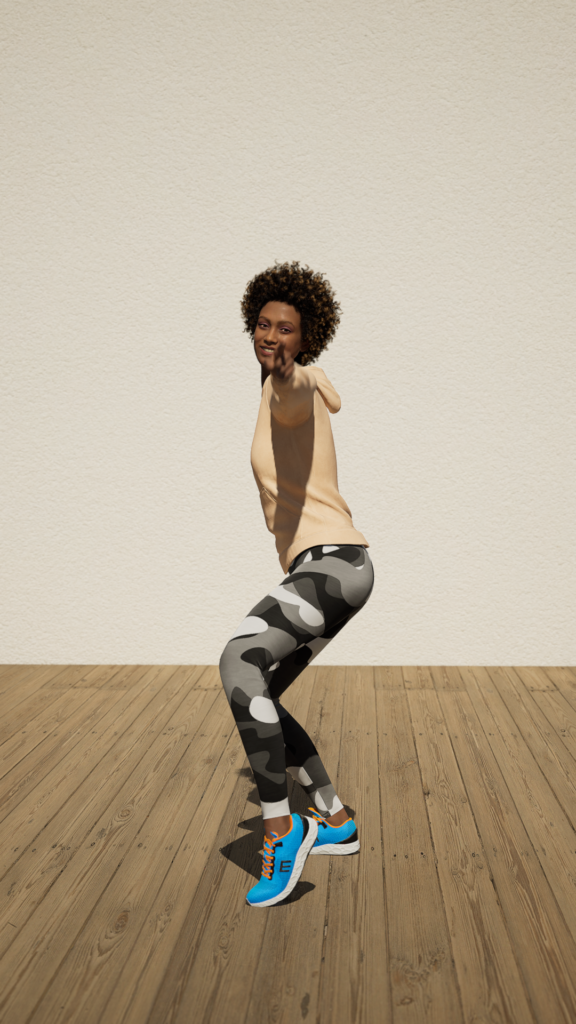In this MotionBuilder tutorial we’ll look at How to Export a MetaHuman Character from Unreal into MotionBuilder and then import the finished animation back into Unreal for rendering.
MetaHuman Dance Challenge
A couple of weeks ago I had the chance to work on some dance mocap, so I thought I’d use the opportunity to have a play with a Metahuman inside MotionBuilder.
Obviously, that isn’t me in the mocap suit and I wasn’t involved in the capture. This was done by Mocap Solutions and the talented Lessi Sitdikova using an Xsens MVN Link mocap system, Faceware headcam and Manus Meta Gloves.
I used MotionBuilder (what else?) to retarget Lessi’s skeleton data onto a Metahuman and then edited the resulting body animation to correct foot-floor contacts, mesh intersections, finger animation (although she’s wearing gloves in the video, the data for the fingers didn’t really work).
Finally, the facial animation and rendering were all done in Unreal 5 – the eagled eyed amongst you may have notice the performer is wearing a head-cam, but that data wasn’t supplied. So, I animated the face in Unreal using the Metahuman face pose library (expertly demonstrated in this video by Feeding Wolves) to create the expressions I could see when the headcam doesn’t cover her face.
Since doing this, a few people have asked about my Metahuman to MotionBuilder workflow, especially how to get the fingers working with IK and how to combine the head and clothing meshes into a single character file in MotionBuilder.
So, using my workflow as an example, I’ll to show you how to:
- Export a MetaHuman Character into MotionBuilder.
- Merge separate mesh files into a single character file.
- Update the shaders and textures to make your Metahuman character look more presentable.
- Set up the fingers to work with the MotionBuilder’s IK Control Rig
- T-Pose and Characterize the character – just quick review as I’ve covered this in detail here, here and here
- Identify one of the few things inertial mocap systems can’t capture and how to fix it.
- Export your finished animation back into Unreal for rendering.
Hopefully, by the end of the video you be ready to start animating your own Metahumans in MotionBuilder.
MetaHuman

MetaHuman is a complete framework that gives any creator the power to create and use highly realistic human characters. It includes MetaHuman Creator, a free cloud-based app that lets you to create fully rigged photorealistic digital humans in minutes.
With near-infinite variations of facial features and skin complexions, plus an array of different choices for hair, eyes, make-up, and teeth, you can create a huge variety of faces for your projects. Pick the body type you want for your character and dress them with different clothing sets in the tool—soon, you’ll have the perfect MetaHuman.
If you want to play with some high-fidelity characters, you can download any of the diverse selection of premade, fully rigged MetaHumans directly from Quixel Bridge, which is now integrated into UE5. If you’re still using UE4, you can download the standalone Bridge application for free.
Editing Mocap on MetaHumans
If you want to learn more about editing mocap on MetaHumans in MotionBuilder, check out my latest course…

Hey Simon, thanks for the fantastic tutorials! I like your level of pro 😉
I was wondering if there is a Python script for metahuman_setup() available somewhere? Are any tutorials planned in this direction? Thank you so much, and good luck!
Hi Ilja,
I have this guide to t-posing and characterizing your character with Python.
It’s not specifically for Metahumans, but it will work if you use the correct Skeleton Definition XML.
Enjoy!
Great tutorial! Thanks so much.
Do you have any advice or shortcuts/resources to share for people fixing broken hands?
Hi Peter, Thanks! Hope it helped.
Yeah, hands, and fingers in particular, aren’t easy I’m afraid – even if you’re capturing them using gloves. It also depends how they’re “broken”. Couple of things you cold try:
“Poses” in MotionBuilder (or equivalent pose systems in other software) are a great help. It means you can create and store hand/finger poses and apply them to your animations, if you’re lucky this can sometimes fixing many “bad” or “broken” fingers. Poses are also really good for video game animations where the character is constantly switching between “relaxed hand”, “fist”, “hold weapon”, etc.
If you have it, video reference is another great tool. You can see what the performer was doing and how and where their hands were aligned, but it still requires manually editing the mocap data to fix the poses
Lastly, delete the data and hand-animated the fingers with a combination of all of the above. Sometimes it ends up being way faster and easier. It pains me to say it as someone who campaigns for preserving as much of the original mocap as possible, but sometimes, it’s more work, time and cost to fix the mocap than it is to animate from scratch.
Feel free to email me if there’s something in particular you’re struggling with.
Hi, Yes, thanks, makes a lot of sense.
I’m going to make sure I’m setting up everything as best it can be (I have the same setup as you in this article) but no doubt I’ll end up emailing you.
Cheers!
Great tutorial. Have you ever had issues with Metahuman weights not exporting correctly from UE? In my case Metahuman heads stretch which looks like some vertices are not weighted fully; they aren’t stuck at their starting point they are trailing behind. Probably have to stop updating to the latest versions. 🙂
Hi Philip,
Thanks and yes I have had issues with skin weights on the MetaHuman head, I’ve even made a tutorial which helps fix it:
https://mocappys.com/how-to-fix-metahuman-face-mesh-in-motionbuilder/